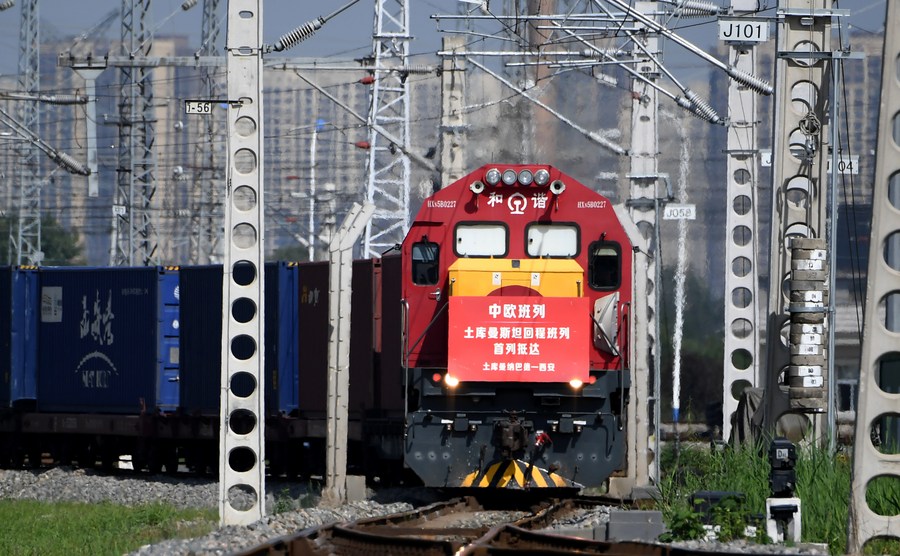China, Central Asian countries strengthen economic and trade ties

A China-Europe freight train loaded with raw materials of liquorice, a Chinese medicinal herb, which departed from Turkmenistan, arrives at Xi'an international port in Xi'an, northwest China's Shaanxi Province, Aug. 31, 2022. (Xinhua/Liu Xiao)
With multiple cooperation documents signed at the China-Central Asia Summit, a high-profile event recently held in China's northwestern city of Xi'an, the economic and trade cooperation between China and Central Asian countries will be further enhanced.
-- Solid foundation in economic and trade ties
China's economic and trade cooperation with the five Central Asian countries has achieved tangible results since the establishment of diplomatic ties more than 30 years ago, the country's Ministry of Commerce (MOC) said in a recent press briefing.
According to Shu Jueting, the spokesperson of MOC, trade between China and the five countries, namely Kazakhstan, Kyrgyzstan, Tajikistan, Turkmenistan and Uzbekistan, has seen improvements in both quantity and quality.
In 2022, bilateral trade volume hit a record high of 70.2 billion U.S. dollars. During the January-March period of this year, trade between China and the five Central Asian countries surged 22 percent year on year.
Meanwhile, the bilateral trade structure has been optimized. China's imports of agricultural, energy and mineral products from Central Asian countries jumped over 50 percent year on year in 2022, while China's export of mechanical and electrical products to these countries rose 42 percent year on year.
In terms of investment, by the end of March this year, China's direct investment stock in the five Central Asian countries reached nearly 15 billion U.S. dollars, covering various fields such as oil and gas exploration, processing and manufacturing, connectivity and digital technologies.
-- Extended cooperation in emerging sectors
While traditional areas of cooperation have yielded results, several experts have noted that economic and trade cooperation between China and the five Central Asian countries are now extending to emerging sectors such as e-commerce, the digital economy and green path of development.
Nearly 60,000 China-Europe freight trains have left China and passed by Central Asia, forming a transportation network for commodity trade between China and the Central Asia, and promoting the booming e-commerce and digital economy between the regions.
Modern technology has further energized trade between China and Central Asia. Official figures showed that in 2022, the cross-border e-commerce trade between the two sides has increased by 95 percent year on year, with nearly 300 Central Asian enterprises selling quality products on Chinese e-commerce platforms.
Green development has become a consensus between China and Central Asian countries. Taking Kazakhstan as an example, China and Kazakhstan have agreed on a project list involving 52 projects with a total value of more than 21.2 billion U.S. dollars in terms of production capacity and investment. New energy projects such as Zhanatas Wind Farm and Turgusun hydropower plant, which were built by Chinese companies, are contributing to the low-carbon transition of the local area.
"The prospects for China-Central Asia cooperation will be even brighter in the future," said Tu Xinquan, professor at the China Institute of WTO Studies of the University of International Business and Economics, adding that apart from pillar industries of the Central Asian countries, such as minerals, energy, and agriculture, China and the Central Asian countries are expected to deepen win-win cooperation in the sectors of digital economy, logistics and technology, and unleash the cooperation potential in transportation, trade, tourism, energy, mining, and healthcare.


